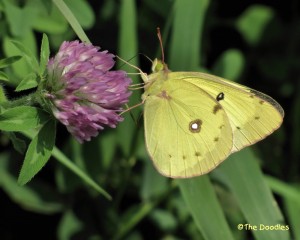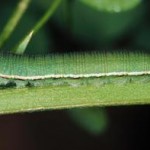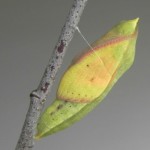What’s a Clouded Sulphur You Ask?

Valerie Assinewe, Professional Writing Intern
From mid-spring to fall, the Clouded Sulphur is the prototypical meadow butterfly, cruising low over the plant tops with a vigorous, searching flight. Here is some information about this bright, fast-moving butterfly.
Species information:
Colias philodice – Clouded Sulphur
Subfamily Coliadinae (Sulphurs), Family Pieridae
Colias are collectively known as Sulphurs in North America, but elsewhere in the world, they are called Yellows.

Clouded Sulphur
Description:
The Clouded Sulphur is a medium-sized butterfly, with a wingspan of 32-54 mm. Males and females are slightly different: males are yellow with a sharp black border on the wings whereas females are a duller yellow with yellow spots inside the black border. The females are dimorphic, many being of whitish hue instead of the yellow colouration. Both sexes have single black spots on the forewings, and dull orange spots on the hindwings. Underneath, there is no black border, but there is a silver spot, outlined in pink, on each hind wing. You can see this when the butterfly is resting with its wings folded.
Life cycle:
After mating, the female Clouded Sulphur lays eggs, one in a place, on clover and other legumes (Fabaceae). The cream-coloured eggs turn reddish in a day or two. These eggs hatch in a few days to a week into small green caterpillars that feed upon the leaves.

Clouded sulphur caterpillar
© Dave Wagner, 2002 / www.discoverlife.org
The caterpillars moult several times during their growth. They hibernate overwinter when in the third or fourth instar. When full grown the caterpillar finds shelter, spins a silken web, and forms a green chrysalis. The chrysalis may overwinter. In non-wintering generations, the fully developed butterfly emerges after 10 days from the cocoon.
There are several broods of Clouded Sulphurs from spring until fall, the actual number depending on the latitude.

Sulphur chrysalis
from tywkiwdbi.blogspot.ca
Distribution:
The Clouded Sulphur is one of the most widespread and common North American butterflies. It flies in all provinces and territories and appears to be absent only from Labrador, the Arctic, and northern Quebec. It ranges north to the Arctic Ocean in Yukon.
Besides lawns and fields, they flit about drinking nectar from many different flowers, including clovers, milkweeds, goldenrods, asters, dandelions, thistles, and sunflowers in parks, gardens, meadows, pastures, stream banks, and roadsides. You may encounter swarms of these sun-loving butterflies on country roads, yellow wings fluttering up from puddles. They are avid mudpuddlers.
Some interesting facts:
- These butterflies are called Sulphurs because their colouration is bright yellow like the solid state of sulphur.
- The Clouded Sulphurs help pollinate plants from which they get nectar. In drinking nectar from a flower, pollen gets on the butterfly’s body. When it goes to another flower of the same type, it accidentally drops off some of the first pollen. This helps the plants grow seeds and spread.
- Predators of the adult Clouded Sulphurs include birds, dragonflies, mantids, frogs. Caterpillars are prey to beetles, squirrels, and shrews
There may be times when other butterflies are more abundant, but the Clouded Sulphur retains its place season after season, with comparatively little noticeable variation in its numbers. This is doubtless an illustration of an insect that has established such relations with its food plants and its various insect and other enemies that it remains in stable equilibrium—an example of the balance of nature.
